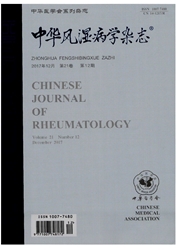

 中文摘要:
中文摘要:
目的探讨抗Jo-1抗体水平与多发性肌炎,皮肌炎疾病活动度的相关性。方法采用免疫印迹法和酶联免疫吸附试验(ELISA)法检测148例多发性肌炎,皮肌炎患者和性别年龄相匹配的130名健康人血清抗Jo-1抗体水平,利用国际肌炎组织制定的炎性肌病评价工具评估抗Jo-1抗体阳性患者疾病活动度(VAS),并分析抗Jo-1抗体水平与多发性肌炎/皮肌炎疾病活动度的相关性。统计学处理采用x2检验或t检验。结果免疫印迹法和ELISA法检测多发性肌炎,皮肌炎患者血清抗Jo-1抗体的阳性率分别是24.3%(36/148)和27.0%(40/148),健康人血清中抗Jo-1抗体均为阴性。发热、肺间质病变(ILD)和关节炎,关节痛在抗Jo-1抗体阳性组的比例明显高于抗Jo-1抗体的阴性组(P〈0.05)。抗Jo-1抗体阳性患者的总疾病活动度评分与血清抗Jo-1抗体的浓度呈正相关(,==0.874,P=0.000)。7例患者治疗后患者血清抗Jo-1抗体浓度与疾病活动度评分均显著下降,两者变化一致。结论ELISA法检测抗Jo-1抗体水平与疾病活动相关,可作为多发性肌炎,皮肌炎疾病活动的评价指标。
 英文摘要:
英文摘要:
Objective To evaluate the correlation between serum anti-Jo-1 antibody level and myositis disease activity in polymyositis/dermatomyositis. Methods Anti-Jo-1 antibody levels in serum from 148 polymyositis/dermatomyositis patients and 130 healthy controls were measured by both ELISA and immunoblot assay. Disease activity of the anti-Jo-1 antibody positive patients was assessed by the global myositis disease activity score (visual analogue score, VAS) established by the International Myositis Assess- ment and Clinical Studies (IMACS) Group. The correlation between disease activity and level of serum anti- Jo-1 antibody was assessed. Comparisons between groups were performed by X2 test or t test. Results The positive rate of ELISA and EUROLINE was 24.3%(36/148) and 27.0%(40/148) respectively. Fever, ILD, arthritis/arthralgia were found to be more predominant in anti-Jo-1 antibody positive patients than those who were anti-Jo-1 antibody negative patients. There was significant positive correlation between the global myositis disease activity score (VAS) and serum level of anti-Jo-1 antibody (r=-0.874, P=-9.000). Serum anti- Jo-1 antibody levels, together with global disease activity, were significantly decreased in the 7 patients after treatment. Conclusion Anti-Jo-1 antibody level measured by ELISA is associated with disease activity of PM/DM, and could be a marker of disease activity.
 同期刊论文项目
同期刊论文项目
 同项目期刊论文
同项目期刊论文
 Anti-MDA5 antibody is associated with A/SIP and decreased T cells in peripheral blood and predicts p
Anti-MDA5 antibody is associated with A/SIP and decreased T cells in peripheral blood and predicts p 期刊信息
期刊信息
